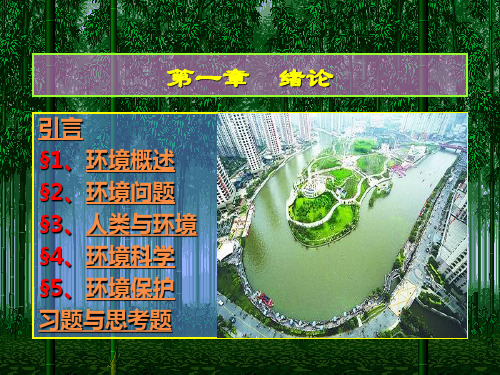环境科学概论教学课件(第三讲)
合集下载
环境科学概论PPT课件

对湖泊的环境磷容量进行测算后,我们可以据此 制订磷排放量的逐年削减和分配排放磷的总量控制 办法。同时,严格的行政管理措施也是必不可少的 。
(3) 实施截污工程或者引排污染源。
截断向湖泊水体排放营养物质的排放源,是控 制某些湖泊水体富营养化的关键性措施。
(4) 合理使用土地,最大限制地减少土壤侵蚀、 水土流失与肥料流失。
• 引水冲洗:用含磷和氮浓度低的水注人湖泊, 起到稀释营养 物质浓度的作用。
• 深水曝气:在不改变水体分层的状态下提高DO浓度,改善 冷水鱼的生长环境,增加食物供给量,改变底泥界面厌氧 为好养,降低内源磷的释放。
• 直接除藻:捞取水体中的丝状藻类和其它漂浮物。 • 超声波技术
超声波技术
• 超声波能在水中产生一系列接近于极端的条件,如超过重力 加速度几万倍的质点加速度,空化泡破裂产生的瞬间高温和 高压(4000K,500大气压)、急剧的放电以及强烈的冲击波和 射流等。由此衍生的二次波、辐射压、声捕捉、自由基、氧 化剂等也可能较大程度地改变介质性质。
二、水体富营养化的危害
影响水体的生态环境:藻类的过度繁殖、死亡会 使水中缺氧,甚至造成厌氧状态。
影响水体的利用:破坏了水体原有的生态系统的 平衡,水不能被人畜直接利用。
加速水体沼泽化、陆地化进程:藻类和水生生物 大量生长和繁殖,加速水体沼泽化和陆地化进程 ,破坏了特定地区的生态平衡。
恶化水源水质,增加给水处理难度和成本:增加水 处理费用,降低处理效果和产水率,水体在一定条 件下因厌氧作用产生硫化氢等有毒有害气体,给水 体处理增加难度。
深度越浅,阳光透过性越好,水体含氧量也越 高,更易产生富营养化问题。
流速越慢,其水循环周期越长,更新速度越慢, 营养物质更易沉积在水底。
(3) 实施截污工程或者引排污染源。
截断向湖泊水体排放营养物质的排放源,是控 制某些湖泊水体富营养化的关键性措施。
(4) 合理使用土地,最大限制地减少土壤侵蚀、 水土流失与肥料流失。
• 引水冲洗:用含磷和氮浓度低的水注人湖泊, 起到稀释营养 物质浓度的作用。
• 深水曝气:在不改变水体分层的状态下提高DO浓度,改善 冷水鱼的生长环境,增加食物供给量,改变底泥界面厌氧 为好养,降低内源磷的释放。
• 直接除藻:捞取水体中的丝状藻类和其它漂浮物。 • 超声波技术
超声波技术
• 超声波能在水中产生一系列接近于极端的条件,如超过重力 加速度几万倍的质点加速度,空化泡破裂产生的瞬间高温和 高压(4000K,500大气压)、急剧的放电以及强烈的冲击波和 射流等。由此衍生的二次波、辐射压、声捕捉、自由基、氧 化剂等也可能较大程度地改变介质性质。
二、水体富营养化的危害
影响水体的生态环境:藻类的过度繁殖、死亡会 使水中缺氧,甚至造成厌氧状态。
影响水体的利用:破坏了水体原有的生态系统的 平衡,水不能被人畜直接利用。
加速水体沼泽化、陆地化进程:藻类和水生生物 大量生长和繁殖,加速水体沼泽化和陆地化进程 ,破坏了特定地区的生态平衡。
恶化水源水质,增加给水处理难度和成本:增加水 处理费用,降低处理效果和产水率,水体在一定条 件下因厌氧作用产生硫化氢等有毒有害气体,给水 体处理增加难度。
深度越浅,阳光透过性越好,水体含氧量也越 高,更易产生富营养化问题。
流速越慢,其水循环周期越长,更新速度越慢, 营养物质更易沉积在水底。
《环境科学概论》PPT课件(2024)

生态系统破坏
生物多样性的丧失导致生态系统功能下降,影响 人类福祉。
生物入侵
外来物种的入侵对原生生态系统造成破坏,威胁 本地物种的生存。
2024/1/30
27
固体废弃物处理问题透视
垃圾围城
城市化进程中,固体废 弃物产生量迅速增长, 处理能力不足导致垃圾 围城现象。
2024/1/30
土壤和水体污染
固体废弃物的不当处理 会对土壤和水体造成严 重污染。
8
水圈层结构与功能
水圈层结构
包括海洋、河流、湖泊、冰川、地下 水等。
人类活动对水圈层的影响
过度开采地下水导致水位下降、排放 污染物导致水体污染等。
水圈层功能
调节地球气候、提供水资源、维持生 态系统平衡等。
2024/1/30
9
岩石圈层结构与功能
2024/1/30
岩石圈层结构
包括地壳、地幔和地核等。
4
环境科学的研究对象与任务
研究对象
主要研究人类活动对自然环境的 影响以及自然环境对人类社会的
反作用。
2024/1/30
研究任务
揭示环境问题的本质和规律,提出 解决环境问题的科学依据和技术途 径,促进环境保护与可持续发展。
研究内容
包括环境地学、环境生物学、环境 化学、环境物理学、环境工程学等 多个分支领域。
2024/1/30
加强环境教育和意识培养
通过环境教育提高公众环保意识,培养环保 行为习惯。
29
THANKS
感谢观看
2024/1/30
30
2024/1/30
14
土壤污染现状及危害分析
土壤污染现状
农业生产中大量使用化肥和农药,以及工业废弃物和城市垃圾的不当处理,导致 土壤受到严重污染。
环境科学概论pptPPT教案

⑵从以上定义可以看出: ①水污染是一种水质恶化的现象。 ②这种恶化是由于水体中进入了某种物质或能量而造成的。
③水体所承纳的物质或能量之多已达到了导致水体水质发 生改变的程度,即超过了水体的自净能力。
④这种变化影响了水的有效利用,即将本来可用于某种目 的的水恶化为只能用于更低目的的水。
⑶造成水体污染的因素包括:向水体排放未经过妥善处理 的
(1)水资源告急
我国可利用的淡水资源量年均1.1万亿m3,但由于工业
废水、生活污水等对水体的污染,至少还要损失3000亿 m3,剩下的淡水仅为人均600m3。因此,许多地方出现了用 水告急。城市平均日缺水量达1600万m3 。据统计,1984年 我国缺水约770亿m3,全国688个城市就有400个供水紧张。 (2)资源性缺水与水质性缺水 ①资源性缺水,来源于人口众多、工农业用水量的增加。
定量、经验分析、行政决策进行。
功能区划分原则:集中式饮用水源地优先保护;水体不得 降
低现状使用功能,兼顾规划功能;有多种功能的水域,依 最
高功能区划类别第;34统页/共筹36考页虑专业用水标准要求;上下游区 域
间互相兼顾,适当考虑潜在功能要求;合理利用水体自净 能
(2)制定水污染综合防治规划 (i)以经济建设为中心,有利于促进经济与环境协调发展。 (ii)以合理开发利用水资源为核心,着眼于全过程控制。
①化学需氧量:COD(Chemical Oxygen Demand)用 化学氧化剂氧化水中有机污染物时所需的氧量。目前常用 的氧化剂主要是:重铬酸钾和高锰酸钾。
②生化需氧量:BOD(Bio-chemical Oxygen Demand)表示水中的有机污染物经微生物分解所需的氧 量(mg/l)。在第29页0℃/共3和6页在BOD的测定条件下以五日作为 测定BOD的标准时间,称之为五日生化吸氧量,以BOD5 表示。
环境学概论PPT课件

2017/7/17
2.4、知识经济时代(后工业时代)
人视自然为朋友 现代,科学技术得到了前所未有的发展; 环境问题依然十分严峻,对人类的生存和发展仍
然构成了极大的威胁; 21世纪的人类面临的十大环境问题; 人类积极进行环境保护。
“绿色文明”
2017/7/17
3、全球性的环境问题
20世纪80年代初,全球气候变暖、臭氧层空洞、酸雨等 三大全球性环境问题已初露端倪,进入20世纪90午代, 地球荒漠化、海洋污染、物种灭绝等环境问题更是突破 了国界,成为影响全人类生存的重大问题。20世纪全球 主要环境问题有: ①全球气候变暖;②臭氧层破坏;③酸雨与空气污染; ④土壤遭到破坏,荒漠化程度加剧;⑤、海洋污染和过 度开发;⑥生物多样性锐减;⑦森林面积减少;⑧有害 废物的越境转移;⑦淡水受到威胁;⑩混乱的城市化。
2017/7/17
人类与环境的关系 环 境
物质和能量 人类社会
废弃物
环
境
2017/7/17
地球元素含量与人体含量关系图
2017/7/17
1.2、人与环境的关系 1)、环境制约着人类的生存和发展 环境是人类赖以生存、进化和发展的物质基础和前提; 人类依靠环境而生存、进化和发展,不断从环境中索取 物质、能源和信息。 一方水土养一方人;批判环境决定论。 2)、人类可以能动的认识、改造环境 能动地调节和控制自身的行为及其结果和影响,从而更 好地去征服、改造和利用环境,并使环境更适合于人类 的发展。 3)、两者的关系是相互联系和相互影响的不可分割的辨 证统一体。 人与环境是密不可分,人类与环境之间的关系是相互联 系和相互影响的。环境对人类的制约性与人对能环境的 能动性是统一的。
2017/7/17
恩格斯的著名论断 “我们不要过分陶醉于我们对自然界的胜利,对于每 一次这样的胜利.自然界都报复了我们。每一次胜利 ,在第一步都确实取得了我们预期的结果,但是在第 二步和第三步却有了完全本同的、出乎预料的影响, 常常把第一个结果又取消了。
环境科学概论--水体环境 ppt课件

ppt课件 29
2.2河流水体中污染物扩散的稳态模型
河流水体稳定状态,污染源连续 稳定排放的条件下,污染物在某一空 间位置的浓度是不变的。
一维模型:只在河流流动x方向上存
在污染物的浓度梯度,横断面方向上 混合均匀。
ppt课件
30
2.2河流水体中污染物扩散的稳态模型
二维模型:只在河流流动x方向和河
微量 溶解气 元素 体 主 要 微 量 胶体 无机 有机 生物生 成物 悬浮物质
Br, O2, F, CO2 Cl-, SO42- Na+, I,F , K+, e, HCO3 Ca2+ Cu, -, N, , CO32- Mg2+ Co
N2, CH4 , H2S
SiO2. 腐 nH2O, 殖 Fe(OH 质 )3.nH 2O, Al2O3 .nH O ppt 课件 2
ppt课件 10
南水北调工程——中线
从长江中游及其主要支流汉水引水,沿伏牛 山及太行山东侧开渠送水,可向北京及黄淮海平 原大部分地区自流送水。 中线全长 1000多公里,年引水量300亿立方 米。其优点是可自流输水,引水量大,还可利用 落差兴建水力发电站。 问题是丹江口水库的大坝需要加高,并且最 终要与三峡水库联系在一起;另外沿山麓输水, 与山地流入平原的河流交叉,输水渠的大交叉就 有200多处。这些山麓地带又是我国著名的暴雨 地区,处理较为困难。
ppt课件 25
1.4水体污染源和污染物
总有机碳,水体中溶解性和悬浮性有机物含碳
的总量,常以“TOC”表示。 TOC是一个快速检定的综合指标,它以碳的数量表 示水中含有机物的总量。由于它不能反映水中有 机物的种类和组成,因而不能反映总量相同的总 有机碳所造成的不同污染后果。 通常作为评价水体有机物污染程度的重要依据。
2.2河流水体中污染物扩散的稳态模型
河流水体稳定状态,污染源连续 稳定排放的条件下,污染物在某一空 间位置的浓度是不变的。
一维模型:只在河流流动x方向上存
在污染物的浓度梯度,横断面方向上 混合均匀。
ppt课件
30
2.2河流水体中污染物扩散的稳态模型
二维模型:只在河流流动x方向和河
微量 溶解气 元素 体 主 要 微 量 胶体 无机 有机 生物生 成物 悬浮物质
Br, O2, F, CO2 Cl-, SO42- Na+, I,F , K+, e, HCO3 Ca2+ Cu, -, N, , CO32- Mg2+ Co
N2, CH4 , H2S
SiO2. 腐 nH2O, 殖 Fe(OH 质 )3.nH 2O, Al2O3 .nH O ppt 课件 2
ppt课件 10
南水北调工程——中线
从长江中游及其主要支流汉水引水,沿伏牛 山及太行山东侧开渠送水,可向北京及黄淮海平 原大部分地区自流送水。 中线全长 1000多公里,年引水量300亿立方 米。其优点是可自流输水,引水量大,还可利用 落差兴建水力发电站。 问题是丹江口水库的大坝需要加高,并且最 终要与三峡水库联系在一起;另外沿山麓输水, 与山地流入平原的河流交叉,输水渠的大交叉就 有200多处。这些山麓地带又是我国著名的暴雨 地区,处理较为困难。
ppt课件 25
1.4水体污染源和污染物
总有机碳,水体中溶解性和悬浮性有机物含碳
的总量,常以“TOC”表示。 TOC是一个快速检定的综合指标,它以碳的数量表 示水中含有机物的总量。由于它不能反映水中有 机物的种类和组成,因而不能反映总量相同的总 有机碳所造成的不同污染后果。 通常作为评价水体有机物污染程度的重要依据。
环境科学概论PPT精品课程课件全册课件汇总

一、环境的概念
环境的概念是相对的。 环境总是相对于中心事物而言的,或者说是相对于 主体而言的客体。中心事物周围的(非中心)事 物就是环境。 环境科学中的中心事物是人(人类社会)。人类的 外部世界,人类周围的一切事物(一般考虑与人 类的生存关系最密切的事物)。中心事物与非中 心事物、或者主体与客体构成一个系统。以人类 社会为主体的外部世界的总体就是环境。
二、环境的划分
按环境要素的属性一般包含自然环境与社会环境: 自然环境(要素):围绕人类的空间中可以直接或间接地影 响到人类生产、生活的一切自然形成的物质及其能量的总 体。例如:太阳辐射、空气、水分、土壤、矿产、动植物、 微生物及地壳的稳定性等自然要素的总和。这些都是人类 赖以生存、生活和生产的物质基础。 社会环境:在自然环境的基础上,经过人类长期的社会劳动 改造形成的,它凝聚了自然因素和社会因素的交互作用, 是人类物质文明和精神文明水平的标志,又随着人类文明 的进程不断丰富和发展。所以,社会环境也称为文化 —社 会环境。 ——人工构筑物、交通运输、通信、经济、文化、道德、 传统、宗教、信仰、科学、技术、社会制度等。
环境问题产生的原因
• 不断增长的人口压力 • 长期不合理的资源利用 • 片面追求经济的增长 ——环境问题的实质是社会、经济、环 境之间的协调发展问题以及资源的合理 开发利用问题。 ——生存-发展-和谐
跨界环境问题磨擦上升
酸雨、沙尘暴—日本、韩国 黄海污染—韩国 跨界河流污染和水资源开发—俄罗斯、朝 鲜、东南亚
环境声学 环境科学是自然科学、社会科学与技术科学之间 环境生物学 环境光学 环境热学 环境物理学 的交叉学科。 环境电磁学
环境基础科 学
环境空气动力学
环境化学 环境Leabharlann 态学 环境医学环境分析化学 环境污染化学 污染控制化学 环境流行病学 环境毒理学 环境医学监测
《环境科学概论》PPT课件

环境污染与干扰:环境污染:有害物质或因子进入 环境,并在环境中扩散、迁移、转化、使环境系 统的结构与功能发生变化,对人类或其他动物的 正常生存和发展产生不利影响的现象。
.
22
按污染物性质分 生物污染 化学污染 物理污染
按环境要素 大气污染 放射性污染 水污染 土壤污染
.
23
环境干扰:是指人类活动所排出的能量进入 环境,达到一定的程度,产生的人类不良 的影响。包括:噪声、振动、电磁干扰、 热干扰等。
4、环境如果按空间尺度大小,由近及远,由 小到大可分为聚落环境、区域环境、全球 环境、星际环境。
.
12
1)聚落环境:是人类群居生活的场所。是人 类利用和改造自然而创造出来的与人类关 系最密切,最直接的生存环境。
居室环境
院落环境
村落环境
城市环境
.
13
2)区域环境:是包括人工环境在内的占有一 定地域的自然环境,区域的范围可大可小, 区域内环境结构特点、功能也千差万别。
.
15
无论从何种角度,进行环境分类,环境都 具有共同的特征。
首先,环境是一个以人类社会为主体的客观 物质体系,对人类社会的生存和发展,它 既有依托作用,又有限制作用,因此环境 有合适与否,或优劣之分。
其次,环境是一个有机的整体,不同地区的 环境由其若干个独立组成部分(环境要 素),以其特定的联系方式构成一个完整 的系统。
.
20
2、次生环境问题:也叫第二环境问题,它是 人类活动作用于周围环境引起的环境问题, 是人类不合理利用资源所引起的环境衰退 和工业发展所带来的环境污染等问题。因 此它是环境科学研究的主要对象。
.
21
环境破坏:又称生态破坏,主要指人类社会活动引 起的生态退化及由此而衍生的有关环境效应,它 们导致环境结构和功能的变化,对人类的生存和 发展产生了不利影响,环境破坏主要是由于人类 活动违背了自然生态规律,急功近利,盲目开发 而引起的。按对象性质分 :生物环境破坏;非生 物环境破坏
.
22
按污染物性质分 生物污染 化学污染 物理污染
按环境要素 大气污染 放射性污染 水污染 土壤污染
.
23
环境干扰:是指人类活动所排出的能量进入 环境,达到一定的程度,产生的人类不良 的影响。包括:噪声、振动、电磁干扰、 热干扰等。
4、环境如果按空间尺度大小,由近及远,由 小到大可分为聚落环境、区域环境、全球 环境、星际环境。
.
12
1)聚落环境:是人类群居生活的场所。是人 类利用和改造自然而创造出来的与人类关 系最密切,最直接的生存环境。
居室环境
院落环境
村落环境
城市环境
.
13
2)区域环境:是包括人工环境在内的占有一 定地域的自然环境,区域的范围可大可小, 区域内环境结构特点、功能也千差万别。
.
15
无论从何种角度,进行环境分类,环境都 具有共同的特征。
首先,环境是一个以人类社会为主体的客观 物质体系,对人类社会的生存和发展,它 既有依托作用,又有限制作用,因此环境 有合适与否,或优劣之分。
其次,环境是一个有机的整体,不同地区的 环境由其若干个独立组成部分(环境要 素),以其特定的联系方式构成一个完整 的系统。
.
20
2、次生环境问题:也叫第二环境问题,它是 人类活动作用于周围环境引起的环境问题, 是人类不合理利用资源所引起的环境衰退 和工业发展所带来的环境污染等问题。因 此它是环境科学研究的主要对象。
.
21
环境破坏:又称生态破坏,主要指人类社会活动引 起的生态退化及由此而衍生的有关环境效应,它 们导致环境结构和功能的变化,对人类的生存和 发展产生了不利影响,环境破坏主要是由于人类 活动违背了自然生态规律,急功近利,盲目开发 而引起的。按对象性质分 :生物环境破坏;非生 物环境破坏
《环境科学概论》PPT课件

研发高效、环保的污染治理和修复技术,解决环 境污染问题。
ABCD
生态系统服务和生态安全
研究生态系统对人类社会的服务功能和生态安全 屏障作用,为生态保护提供理论支持。
可持续发展战略和政策研究
研究可持续发展战略和政策措施,为推动绿色发 展提供决策参考。
THANKS
感谢观看
REPORTING
城市生活污水、垃圾等废弃物对周围环境造成污染,影响居民生 活和健康。
城市热岛效应
城市化进程中大量建筑物和道路等人工构筑物导致城市热岛效应 加剧,影响城市气候和居民生活。
能源开发利用过程中环境问题认识
化石能源开采利用 煤炭、石油等化石能源的开采和利用过程中会产生大量废 气、废水和固废等污染物,对环境和人类健康造成影响。
功能
提供生物栖息地,维持生物多样性,调节气候和水文循环,净化空气和水质,以及为人 类提供食物、能源和休闲场所等生态服务。
PART 03
人类社会活动对自然环境 影响评价
REPORTING
工业生产排放污染物种类及危害程度评估
废气排放
包括二氧化硫、氮氧化物、颗粒 物等,对大气环境造成污染,影
响人类健康。
REPORTING
大气污染防治技术路线选择
源头控制
通过改进生产工艺、使用清洁能源等方式减少大 气污染物排放。
治理技术
采用除尘、脱硫、脱硝等大气污染治理技术,降 低污染物浓度。
监测与监管
建立完善的大气环境监测体系,加强监管力度, 确保污染物达理法、化学法和生物法等多种水体污染治理方法。
和人类健康。
畜禽养殖排放
02
畜禽粪便和废水排放对周围环境造成污染,影响居民生活和农
业生产。
农业废弃物
ABCD
生态系统服务和生态安全
研究生态系统对人类社会的服务功能和生态安全 屏障作用,为生态保护提供理论支持。
可持续发展战略和政策研究
研究可持续发展战略和政策措施,为推动绿色发 展提供决策参考。
THANKS
感谢观看
REPORTING
城市生活污水、垃圾等废弃物对周围环境造成污染,影响居民生 活和健康。
城市热岛效应
城市化进程中大量建筑物和道路等人工构筑物导致城市热岛效应 加剧,影响城市气候和居民生活。
能源开发利用过程中环境问题认识
化石能源开采利用 煤炭、石油等化石能源的开采和利用过程中会产生大量废 气、废水和固废等污染物,对环境和人类健康造成影响。
功能
提供生物栖息地,维持生物多样性,调节气候和水文循环,净化空气和水质,以及为人 类提供食物、能源和休闲场所等生态服务。
PART 03
人类社会活动对自然环境 影响评价
REPORTING
工业生产排放污染物种类及危害程度评估
废气排放
包括二氧化硫、氮氧化物、颗粒 物等,对大气环境造成污染,影
响人类健康。
REPORTING
大气污染防治技术路线选择
源头控制
通过改进生产工艺、使用清洁能源等方式减少大 气污染物排放。
治理技术
采用除尘、脱硫、脱硝等大气污染治理技术,降 低污染物浓度。
监测与监管
建立完善的大气环境监测体系,加强监管力度, 确保污染物达理法、化学法和生物法等多种水体污染治理方法。
和人类健康。
畜禽养殖排放
02
畜禽粪便和废水排放对周围环境造成污染,影响居民生活和农
业生产。
农业废弃物
《环境科学概论》PPT课件

.
20
2、次生环境问题:也叫第二环境问题,它是 人类活动作用于周围环境引起的环境问题, 是人类不合理利用资源所引起的环境衰退 和工业发展所带来的环境污染等问题。因 此它是环境科学研究的主要对象。
.
21
环境破坏:又称生态破坏,主要指人类社会活动引 起的生态退化及由此而衍生的有关环境效应,它 们导致环境结构和功能的变化,对人类的生存和 发展产生了不利影响,环境破坏主要是由于人类 活动违背了自然生态规律,急功近利,盲目开发 而引起的。按对象性质分 :生物环境破坏;非生 物环境破坏
特点:1、全人类面临的共同性问题;
2、已从局部扩展到区域甚至全球, 从地表到高空及地下,呈立体态;
3、表现形式要加多样化;
.
19
4、具有明显的地域性;
5、已严重损害人类的健康与福利,威胁人类 生存和发展。
三、环境问题分类
1、 原生环境问题:也叫第一环境问题,它 是自然环境自身变化引起的,没有人为 因素或很少有人为因素参与,使人类社 会遭受一定损害的问题。包括地震、火 山活动、滑坡、泥石流、台风、洪水、 干旱等等。
• 对于环境科学来说,中心事物是人,“环 境”就是人类生存的环境,指的是环绕于 人类周围的客观事物的整体,它包括自然 因素,工程因素和社会因素。
.
9
二、环境的分类和组成 1、 自然环境:是人类发生和发展的物质基
础,它是由生物及其生存环境所组成的。 大气 水体
要素 土地 岩石 生物
.
10
自然环境还可以从各种不同的角度作进一步 分类。
以自然环境为主体的区域环境有:森林、草 原、沙漠、冰川、海洋、湖泊、河流、山 地、平原等多种类型。
以人工环境为主体的区域环境有:城市、农 村、工业区、旅游区,开发区等 。
环境科学概论全套课件 完整版457p

量,一般都达到30%左右,仅仅太阳上那种氢合成氦的 作用,是不能造出这么多氦的,而大爆炸能做到 因爆炸而使星系间的距离拉开,更已是熟知的事实 天文观测中已多次记录到超新星爆炸 另外新近得到的两个黑洞撞击爆炸的信息,都可以作 为佐证。
冷暗物质------最新证据!
1.1.2 太阳系出现-大爆炸发生 约100亿年之后 ---星云学说
氢和氦的含量都很少 而是铁占了第一位,其次是氧和硅,
还有很多镁、镍和铝等金属 地球的化学组成为何如此不同?
1.1.3.1 地球的形成
在太阳系内,由于接受的太阳辐射多,温度高,
轻的气体被辐射到远处,散失到太阳系的外部 远处构成类木行星 近太阳的地区,以尘埃中的固体物质为主,化 学组成当然和原来的星云有显著的不同(铁、 硅、镁、氧为主) 近处构成类地行星
文观测继续有新的发现,证明宇宙在膨胀,曾测到 有的河外星系之间,正以每小时2,500,000km的速 度在拉开距离。
《BIG BANG》-大爆炸
宇宙的全部物质,当初都集中在一个“原始原子”(或
称宇宙蛋)里,异常紧密 温度约1032°K,绝对温度1亿亿亿亿度 显然这只能维持极其暂短的平衡,一旦平衡破坏,就发 生大爆炸,原始原子迅速膨胀,逐渐扩展成为我们的宇 宙
哲学家康德(Immanuel Kant, 1724-1804) - 星云说
在献给普鲁士国王的《自然通史和天体理论》中假
定:最初“整个宇宙的物质都处于分散的状态,并 由此造成一种完全的混沌”,“ 构成我们太阳系的 星球的物质,在太初时都分解为基本微粒,充满整 个的宇宙空间,现在已形成的星体就在这空间中运 转”。他认为是万有引力的作用,使这些原始的弥 漫物质逐渐分别凝聚,形成了太阳系内的各天体。
- 1、下载文档前请自行甄别文档内容的完整性,平台不提供额外的编辑、内容补充、找答案等附加服务。
- 2、"仅部分预览"的文档,不可在线预览部分如存在完整性等问题,可反馈申请退款(可完整预览的文档不适用该条件!)。
- 3、如文档侵犯您的权益,请联系客服反馈,我们会尽快为您处理(人工客服工作时间:9:00-18:30)。
cactus
13
camel
广东工业大学 环境科学与工程学院
Temperate grassland: also known as prairies or steppes, are widely distributed over temperate parts of the world. Climate: As with deserts, the major factor that contributes to the establishment of a grassland is the amount of available moisture. Grasslands generally receive between 25 and 75 centimeters of precipitation per year. These areas are windy with hot summers and cold to mild winters.
2
1. Succession
广东工业大学 环境科学与工程学院
Succession The communities proceed through a series of recognizable, predictable changes in structure over time is called succession. Primary Succession Primary succession is a successional progression that begins with a total lack of organisms and bare mineral surfaces or water. Terrestrial Primary Succession Aquatic Primary Succession Secondary Succession An original community is a successional progression that begins with destruction or disturbance of an existing ecosystem.
4
广东工业大学 环境科学与工程学院
Primary succession can begin on a bare rock surface, or in standing water.
A pioneer organism :Lichen (Terrestrial ecosystem)
5
Terrestrial primary succession
广东工业大学 环境科学与工程学院
Emergent plants
Early stages – Aquatic vegetation
Wet meadow
Grassland
8
Later stages – Transition to Terrestrial communities
广东工业大学 环境科学与工程学院
2 Biomes are determined by climate Biomes
广东工业大学 环境科学与工程学院
3 Major biomes of the world
广东工业大学 环境科学与工程学院
The effect of elevation on climate and vegetation Deserts: Climate: A lack of water is the primary factor that determines that an area will be desert. Deserts are areas that generally receive fewer than 25 centimeters of precipitation per year. Organisms: few species of organisms live in the desert. There are many species, but they typically have low numbers of individuals.
广东工业大学 环境科学与工程学院
Pioneer stages
Intermediate stages
6
Climax community
广东工业大学 环境科学与工程学院
Process of terrestrial succession
Aquatic primary succession Floating plants Submerged plants
Observing aquatic succession
广东工业大学 环境科学与工程学院
Most aquatic ecosystems are considered temporary (except ocean).
10
Secondary Succession
广东工业大学 环境科学与工程学院
11
3
广东工业大学 环境科学与工程学院
Community: is an assemblage of all the interacting populations of different species of organisms in an area. Climax community: The relatively stable, long-lasting community that is result of succession.
CHAPTER THREE: Kinds of Ecosystems and Communities
广东工业大学 环境科学与工程学院
Forest
Coral reef
Desert
Swamp
广东工业大学 环境科学与工程学院
OBJECTIVES After reading this chapter, you should be able to: Recognize the difference between primary and secondary succession. Describe the process of succession from pioneer to climax community in both terrestrial and aquatic situations. Describe how the concepts of succession and climax community developed and how they are used today. Identify the major environmental factors that determine the kind of community that develops in an area. State major abiotic and biotic characteristics of the various terrestrial biomes. State abiotic difference between marine and fresh water ecosystem. State how pelagic and benthic ecosystem differ. Describe the role of phytoplankton and zooplankton in aquatic ecosystems. State biotic differences between marine and freshwater ecosystems.
广东工业大学 环境科学与工程学院
Tropical Dry Rainforest: is heavily influenced by seasonal rainfall.
Climate: Many of the tropical dry forests have a monsoon climate in which several months of heavy rainfall are followed by extensive dry periods ranging from a few to as many as eight months. the rainfall may be as low as 50 centimeters or as high as 200 centimeters, but since the rainfall is highly seasonal, many of the plants have special adaptations for enduring drought. Organism: many of the plants have special adaptations for enduring drought.
Organisms: The plants and animals time their reproductive activities to coincide with the rainy period.
广东工业大学 环境科学与工程学院 Mediterranean Shrublands (Chaparral): are located near oceans and are dominated by shrubby plants. Climate: have a climate with wet, cool winters and hot, dry summer. Rainfall is 40 to 100 centimeters per year. Organisms: the vegetation is dominated by woody shrubs that are adapted to withstand the hot, dry summer.
